PUT MOUSE OVER
| CONTENTS | ||
| 1. "The Blind Beggar" No. 1. | |||
| 2. "The Blind Beggar" No. 2. | |||
| 3. "The Blind Beggar" No. 3. | |||
| 4. Sir Wyndham Deedes | |||
| 5. Alice Denman Fountain | |||
| 6. Dinosaur in School | |||
| 7. Grand Park Entrance | |||
| 8. "Eagle Slayer" | |||
| 9. "Justice" | |||
| 10. London Buddhist Centre | |||
| 11. London Chest Hospital | |||
| 12. Karl Marx | |||
| 13. Daniel Mendoza | |||
| 14. "Motherhood" | |||
| 15. Museum of Childhood | |||
| 16. Netteswell House | |||
| 17. Queen Margaret & Mr Chamberlain | |||
| 18. Decorated Paving Stones | |||
| 19. Prosperity | |||
| 20. Raines Scholar | |||
| 21. The Salmon & Ball | |||
| 22. Shelter Disaster | |||
| 23. Toys in the Pavement | |||
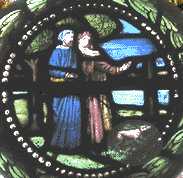 |
The Blind Beggar 1. |
|
Stained glass in the memorial window in Bethnal Green Library. Detail from the central panel ("Peace"). (See No. 1. on the MAP ) Date: 1923. |
||
 |
The Blind Beggar 2. |
|
On the north face of the newer part of the Tower Hamlets Council Buildings in Patriot Square. The building was originally Bethnal Green Town Hall. The old ballad described the beggar: He alwayes is led with a dogg and a bell. By 1690 he was already pictured on the Beadles official stave. His daughter is also remembered in Bethnal Green by Bessee Street off Roman Road. For the story of the Blind Beggar see the entry by that name on the Whitechapel page. (See No. 2. on the MAP ) |
||
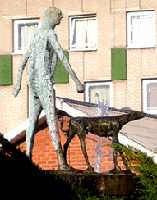 |
The Blind Beggar 3. |
|
Roman Road. Statue and fountain in the gardens of bungalows on the Cranbrook Estate, near the Mace Street junction with Roman Road. It is interesting to compare the 1923 and 1938 representations above with this one of 1963. By now the little puppy has grown up to be a full sized guide dog. Whereas before the beggar was shuffling along gingerly on his daughter's arm, he is now striding out confidently with the help of the guide dog. The training of guide dogs only started in 1931 in Britain, so the earlier artists could not introduce one into a mediaeval story. (See No. 3. on the MAP ) Sculptress: Elizabeth Frink. Date: 1963. |
||
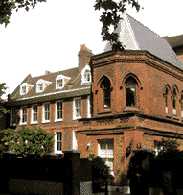 |
Sir Wyndham Deedes. |
|
18 Victoria Park Square. Brigadier General Sir Wyndham Henry Deedes (1883 � 1956) lived here from 1923 to 1939 while serving as principal of the University House Settlement. Deedes had been at Gallipoli, After the war in 1920, he was sent to Palestine to be the senior secretary of the British administration there. In this capacity tried to mediate between the three sides - the British the Arabs and the Zionists. He was one of the few British establishment figures who were sympathetic to the Jews. In 1923, he returned to Britain to do social work in the East End. There is a commemoration plaque on the side wall of the old chapel building. The houses numbered 17 and 18 were built about 1690. (See No. 4. on the MAP ) |
||
 |
Alice Denman Fountain. |
|
Drinking fountain in the South-west corner of the little park next to the Museum of Childhood, Cambridge Heath Road. The inscription states: This was a three storey building. The ground floor was occupied by a ticket-writers and the upper floors were living accommodation for Mr and Mrs Denman, their 6 children and a woman lodger. When the fire broke out, Alice managed to bring out two daughters to safety. The fire spread rapidly, but Alice went back for the remaining children as did Mr Regelous, who was a passer-by. Altogether there were 7 casualties. Alice, Peter, four of Alice's children and the lodger. Mr Denman arrived home to be told of the tragedy. The fountain was put up after a public collection. (See No. 5. on the MAP ) |
||
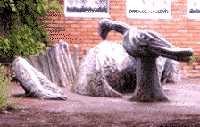 |
A Dinosaur in School. |
|
At the back of St Elizabeth's Roman Catholic Primary School, which is visible from Bishop's Way. The creature appears to have similarities to a Parasaurolophus, a dinosaur from the Upper Cretaceous period. In which case, it would have lived about 80 million years ago. For the origin of Bishop's Way see London Chest Hospital. (For Dinosaur see No. 6. on the MAP ) |
||
 |
Grand Entrance to a Park. |
|
The entrance to Meath Gardens, near to Sylvia Pankhurst House. This is at the end of Bullards Place. Over the top of the arch is written V.P.C. 1845. The letters stand for the Victoria Park Cemetery, which existed here from 1845 - 1874, when it became full. The fact that the cemetery closed after only 29 years shows the high rate of mortality in the area during the 19th century. The gardens were opened in 1893. (See No. 7. on the MAP ) |
||
 |
"Eagle Slayer." |
|
Figure a man aiming his bow at the sky trying to kill the eagle that had killed one of his sheep. At first sight the statue appears to be of white stone, but is in fact cast iron covered in white paint. The statue originally stood outside the Museum of Childhood in Cambridge Heath Road, but has now been moved inside the building on the ground floor. It is still on free display as the museum makes no charge for admission. (See No. 8. on the MAP ) Sculptor: John Bell. Date: 1851. |
||
 |
"Justice" |
|
This Sculpture is on the north face of the older part of Tower Hamlets Council Building in Patriot Square. Showing a female figure holding the scales of judgement and the sword of justice. (See No. 9. on the MAP ) Sculptor: Henry Poole. Date: 1909. |
||
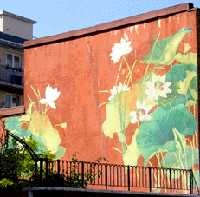  |
London Buddhist Centre. |
|
Left. Large mural behind the Buddhist Centre, visible from the junction of Globe Road and Roman Road E2. The size of this mural can be judged by comparing it to the railings in front of it which are about a metre high. Right. A sculpture over the gateway in Globe Road, which shows the Nalanda crest with other symbols. This includes a lotus flower, a pair of deer and the wheel with eight spokes symbolic of the path to enlightenment. Nalanda was the name of a university which flourished in India from the 5th century BCE to about 100 CE. The design of the crest is at least a thousand years old. The Temple building used to be a fire station. (See No. 10. on the MAP ) Gateway Artist: Arya Daka. Date: c. 1978. |
||
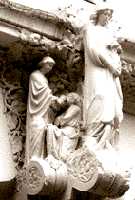 |
London Chest Hospital. |
|
Statue over the old door of the hospital at the junction of Bonner Road and Approach Road. The figures show nurses tending patients. Built in the 1850s, this was one of the first hospitals built to care for Tuberculosis patients in London. Previously the site had been part of the grounds of Stepney Manor House, which had been the property of the Bishop of London from the beginning of the thirteenth century. This accounts for the road name of Bishop's Way which once led to the house. Bonner Road is named after Edmund Bonner (1500-1569) who was made Bishop of London in 1540 by Henry VIII. But later he was imprisoned because he did not accept the King as head of the church. He was released by Mary and restored to office. As bishop, he sentenced many Protestants to martyrdom and was known as "Bloody Bonner". (See Stratford Martyrs Memorial for some of his victims) Under Elizabeth, he was again sent to prison and died there. (See No. 11. on the MAP ) |
||
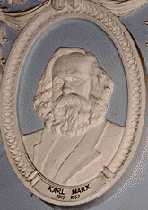 |
Karl Marx. |
|
In Bethnal Green Public Library off Cambridge Heath Road. Karl Marx (1813 � 1883) was the founder of Communism. In 1848 in collaboration with Frederich Engels he published the "Communist Manifesto". In 1867 he began to publish "Das Kapital" a 3 volume work attacking the inequalities of capitalism and advocating an egalitarian form of socialism. This had a profound affect upon the following hundred years of history. Also featured in the Library are Charles Darwin, William Morris and Richard Wagner. (See No. 12. on the MAP ) Sculptor: Karl Roberts. Date: 1922. |
||
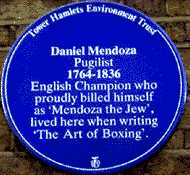 |
Daniel Mendoza. |
|
3 Paradise Row. Daniel Mendoza (1764-1836) born in Aldgate to Sephardi Jewish parents, became boxing champion of England. In 1790 he defended his title and won the contest in a fight that lasted 72 rounds. He introduced science and skill into boxing which had previously been a matter of brute strength. Although he was not a heavyweight, he was able to defeat bigger opponents because of his speed, agility and skill. On his retirement from the ring he wrote a book called "The Art of Boxing", and became the landlord of a pub in Whitechapel. (See No. 13. on the MAP ) For other Jewish blue plaques see Blue Plaques |
||
 |
"Motherhood." | |
Stained glass window on the first floor of Bethnal Green Library just off Cambridge Heath Rd. This is one of a group of three windows in remembrance of those who fell in World War 1. The other two windows are "Peace" and "Manhood". The Library stands on the site of Bednal Hall/Bethnal House (also called Sir John Kirby's Castle). It was later used as a Lunatic Asylum. The library was built in 1896 after the old building had been pulled down. However the green area in front of the Library is still called "Barmy Park" by some local residents. From the 17th century, the green was part of what was known as Poor's Land. Some local landlords enclosed an area of waste land on both sides of the main road in the 1670s and declared that the income from it would be used for poor relief like distributing fuel in winter, etc. All that now remains of the Poor's Land is this green area and the little park by the Museum of Childhood. (See No. 14. on the MAP ) Date: 1923. |
||
 |
Museum of Childhood. |
|
One of a series of mosaic panels decorating the exterior walls of the museum in Cambridge Heath Road. This is on the northern wall where the subjects are arts and science: (Botany, Mechanics, Spectral Analysis, Chemistry, Geometry, Astronomy, Science Art & Thought, Poetry, Music, Sculpture, Architecture & Building, Painting, Pottery) On the Southern wall there are pastoral activities: (Ploughing, Sowing & Hoeing, Training Trees, Mowing, Haymaking, Shearing Sheep, May Flowers, Wheat Harvest, Hopping, Picking Apples, Fishing, Buying Beasts, The Dairy.) The males and the children are mostly unclothed but the female figures are all in classical dress. The mosaics were designed by F W Moody, but were made by women students of the Art Training School of South Kensington. | ||
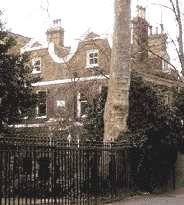 |
Netteswell House. |
|
Next to the Museum of Childhood is in Victoria Park Square. This is the oldest house in Bethnal Green. In 1547 Bishop Bonner leased a cottage on this site to Sir Ralph Warren, a former Lord Mayor of London. Parts of the basement date back to (1553), though the upper structure was remodelled in 1705 and in 1862. It was to Bethnal House, house near here, that in 1666 Samuel Pepys brought his books and other possessions including his diary to escape destruction in the Fire of London. (See No. 16. on the MAP ) |
||
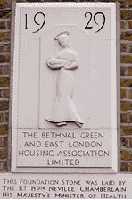 |
Queen Margaret and Neville Chamberlain. |
|
At the Junction of St Judes Street and Middleton Street, there is now a large block of apartments called Queen Margaret's Flats. The foundation stone was laid by Neville Chamberlain, who was then minister of health (1924-29) and was nine years later the prime minister who came back from a meeting with Hitler waving a meaningless piece of paper. Chamberlain had a strong belief that removing the slums and replacing them by good housing would improve the nation's health. Queen Margaret (1046-1093) was the grand daughter of the Anglo-Saxon King Ethelred the Unready and niece of King Edward the Confessor. She married the Scottish King Malcolm III whose father Duncan had been murdered by Macbeth. Three of her sons later became kings: Edgar, Alexander I and David I. She played a major role in the affairs of the early Scottish church and was renowned for her charitable works. She was canonised in 1250 and this accounts for the halo shown in the sculpture. (See No. 17. on the MAP ) |
||
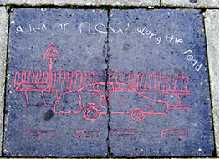 |
Decorated Paving Stones. |
|
Roman Road, near the junction with Morpeth Street. This is one of several stones decorated with children's drawings which have been set into the pavements at various places. The inscription reads "A red car flew along the road." And a small sign says that the road in question was Roman Road. Other similar stones can be found in Bonner Street, Morpeth Street and behind the Museum of Childhood. (See No. 18. on the MAP ) | ||
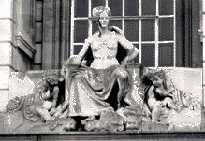 |
Prosperity. |
|
Over the front entrance to the old Town Hall in Cambridge Heath Road. The statue shows a stately matron (The Council) guarding and caring for two children (the industries of Bethnal Green). The council is apparently so successful that a rich harvest of fruit is pouring out of the two cornucopia held by the children. (See No. 19. on the MAP ) Sculptor: Henry Poole. Date: 1909. | ||
 |
Raines Scholar. |
|
Approach Road. On the front of the Raines School building there are the figures of a boy and a girl dressed in the original blue uniform used by the school. Compare these to the figures on the original building in Wapping. The motto which was placed over the door there in 1719 is still quoted on the notice board in front of this building. (See No. 20. on the MAP ) | ||
 |
The Salmon and Ball. |
|
On the corner of Bethnal Green Road and Cambridge Heath Road. Although the present building only dates from the mid 19th century there has been a pub by that name here since at least 1763, when it was reported that a double public hanging took place outside the pub. (See No. 21. on the MAP ) | ||
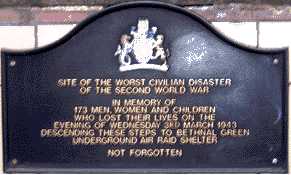 |
Shelter Disaster. |
|
Commemorative plaque at entrance to the underground station at the corner of Roman Road and Cambridge Heath Road. During the second world war, underground stations were used as air raid shelters. In March 1943 a battery of the new anti-aircraft rocket launchers was installed in Victoria Park to defend against German raiders. Because of wartime secrecy the local inhabitants were not informed. On the first occasion of their use the unusually loud noise made people think that the Germans had a new secret weapon and they rushed for shelters. Someone tripped on the stairs and as a result 173 lives were lost, mostly from suffocation. (See No. 22. on the MAP ) | ||
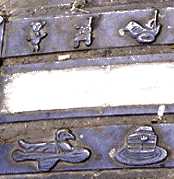 |
Toys on the Pavement. |
|
Around the entrance to the underground which is in front of the Salmon & Ball public house. There are several metal arcs let into the pavement and these have tiny figures carved on them. As they include a teddy bear and what looks suspiciously like a duck flying in an aeroplane, these must be linked to the Museum of Childhood which is only a few hundred yards away. (See No. 23. on the MAP ) Artist: A J Bernasconi. Date: 2004. |
||
OTHER AREAS COVERED:-
|| Beckton || Blackwall || Bow || Bromley-by-Bow || Canary Wharf || Canning Town || Chingford || Cubit Town || Custom House || East Ham || East India Dock || Forest Gate || Higham's Park || Leyton || Leytonstone || Limehouse || Little Ilford || Manor Park || Mile End || Millwall || North Woolwich || Plaistow || Plashet || Poplar || St George's || St Katharine Dock || Shadwell || Shoreditch || Silvertown || Snaresbrook || Spitalfields || Stepney || Stratford || Upton || Walthamstow East || Walthamstow Village || Walthamstow West || Wanstead || Wapping || West India Dock || Whitechapel || Woodford || |
 TO READ NAME
TO READ NAME